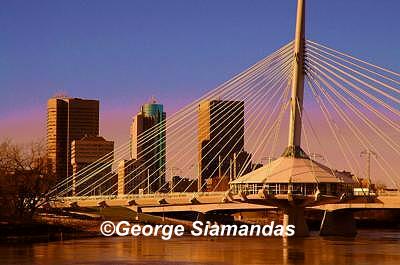by George Siamandas
A PROUD DAY FOR WINNIPEG IN 1886
On Nov 22, 1886, Winnipeg city council held their first meeting in their just-completed Victorian City Hall. It was a proud day, and Winnipeg had come a long way by 1886. Just 15 years earlier there had been no city, no railway, no streets, no schools and no churches. Now there were massive mercantile blocks, railway connections in every direction, streetcars, fine homes and all the growing conveniences of a major city. They were happy to be in their new building after the fiasco of the first city hall which saw controversy over shoddy construction. And there was controversy over the new one which was two years late in completion.
EARLIER CITY HALL WAS POORLY BUILT
The first one built a few years earlier certainly had its problems. The brick work was done in cold weather and the building just literally fell apart in just few years requiring a new one to be rebuilt from scratch in 1886. It was also constructed over a creek called Brown's Creek and there were perpetual settling problems for the next one too. City Hall was a gem. It had towers at each corner with a central domed clock tower flying the Union Jack rising high above the city as the major landmark on Main Street. It was built of red brick with limestone detailing. Very ornate and often described as gingerbread style.
The old city hall demolished came down in 1962. But many consider that it had already been more than 50 years overdue. In 1913 a new city hall was being planned to go near the legislative building as part of a mall that would run from Portage Avenue to Broadway Ave. It was the result of a world wide design competition that saw 39 entries. That plan was scraped never proceeded with due to the 1913 recession followed by WW1 and then the doldrums of the 1920s and then of course the depression and WW2. The province tried to resurrect the Broadway location in the 1950s but it was not to be. The city decided to stick with Main St.
The old City Hall had been designed by Barber and Barber (Charles and Earl) two of Winnipeg's earliest architects. They had also built the earlier structure. There is very little that remains of the more than 90 buildings that Barber and Barber built. I believe that the Leland Hotel, the Exchange Bldg at 164-166 princess and the Bawlf Block at 148 Princess St. St. may be the only Barber buildings that are left in Winnipeg.
There was a lot of debate over its demolition at the time. Some people wanted to save it. But their conservationist message was about 10-15 years ahead of its time, and their arguments feel on deaf ears. There were more people that wanted to bring Winnipeg into the modern decade. There had been very little new construction and Winnipeg still looked like a city from the Victorian and Edwardian period which indeed it was architecturally. Building a new city hall was seen as coming out of the Dark Ages and a sign that Winnipeg would become a modern city too.
And Mayor Juba was an effective champion of the need for progress; and a great persuader. And he was able to graphically convince the media that it was not worth saving. There is a story of how he took a reporter up to one of the towers on a windy day to show him how it swayed in the wind and that it was not safe and therefore not worth saving. What the reporter didn't know is that Juba made it shake by pulling on the flagpole above the tower. Bernie Wolfe describes as more of a tilt of the imagination rather than a tilt in the building.
Today's City Hall is a rather understated building and most people shake their heads when they hear the story of the old building and see pictures of it. But that the city rebuilt it on the original site showed it believed in Main St. One wonders what would have happened on Main St. if it had been moved to another location and the whole area had been allowed to deteriorate even further.
What remains of the old city hall? The bell is said to be part of a bell tower on Selkirk Ave, and elements from the clock are part of the clock at Portage Place, and apparently some of the brick was used on the front of a house in St Vital. Other stories say that much of it ended up in a wreckers yard as fill on the driveway.


No comments:
Post a Comment